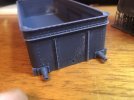Well, as Albert’s mother said, “I am vexed”
Monday night, set up the printer to do 45 pieces of gutter for the loco shed, and had an inviting gap on the printer bed. “Mmm”, says I, “I’ve already updated that iron coal wagon, let’s have a couple of them on there.
14 hour print…
Back from the office yesterday and fed the cat (not going to get any peace until that’s sorted) and then took the print off and washed it. Looks good, put it in the curing box, and then unpacked.
The gutters are ok, good,

The wagon bodies are looking fine



Though there’s a bit of ripple in the top flanges, I’m thinking, “we’re very nearly there”
But

The end with the supports on is rough.

The ripple in the flange is dreadful, and despite using rivets as the support points, it has left an awful finish.
Back to the print set up. I’ll have another go tonight.




























 Wouldn't it be great if that's the effect you wanted and you didn't have to draw it in 3D CAD.
Wouldn't it be great if that's the effect you wanted and you didn't have to draw it in 3D CAD. 